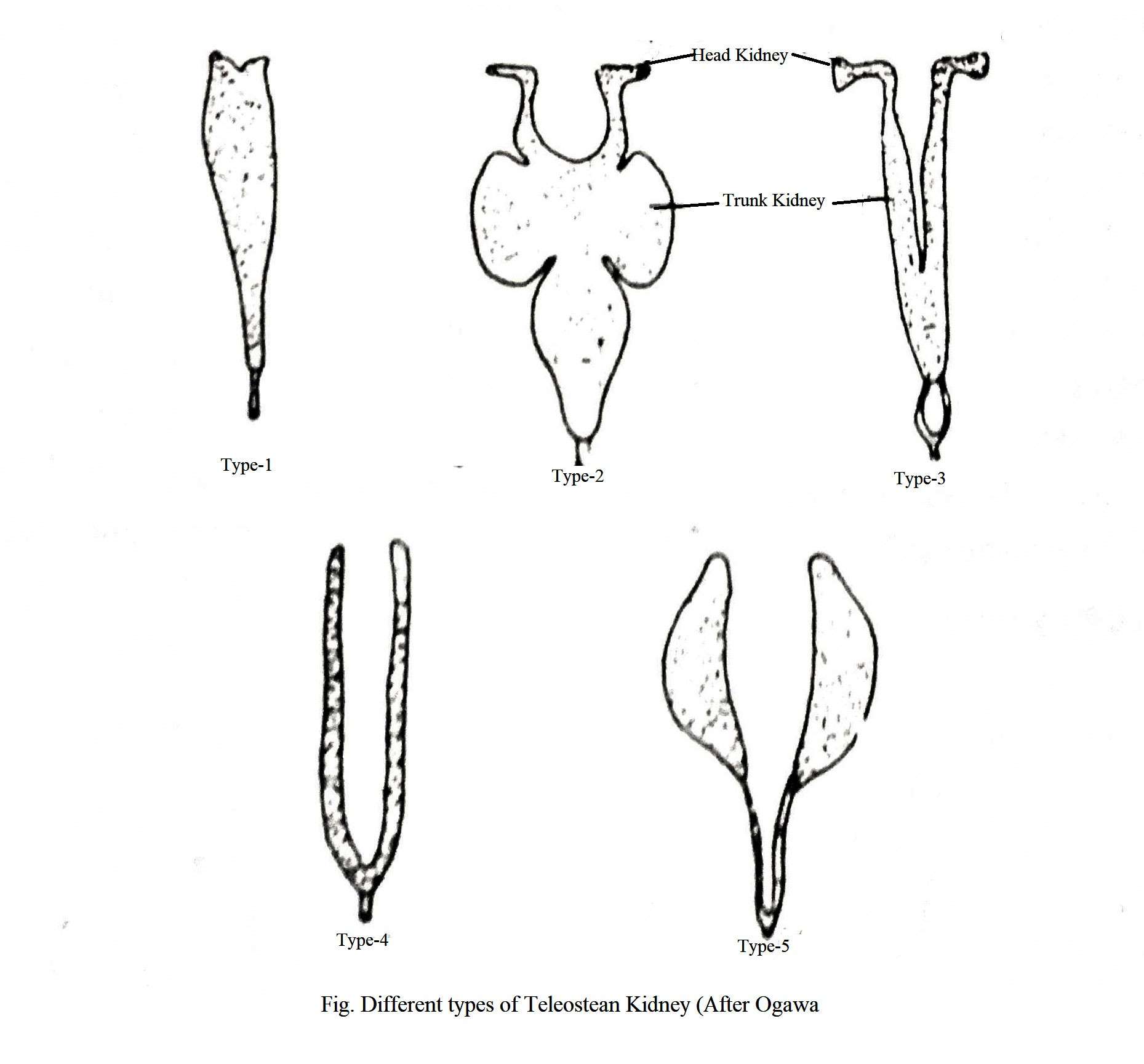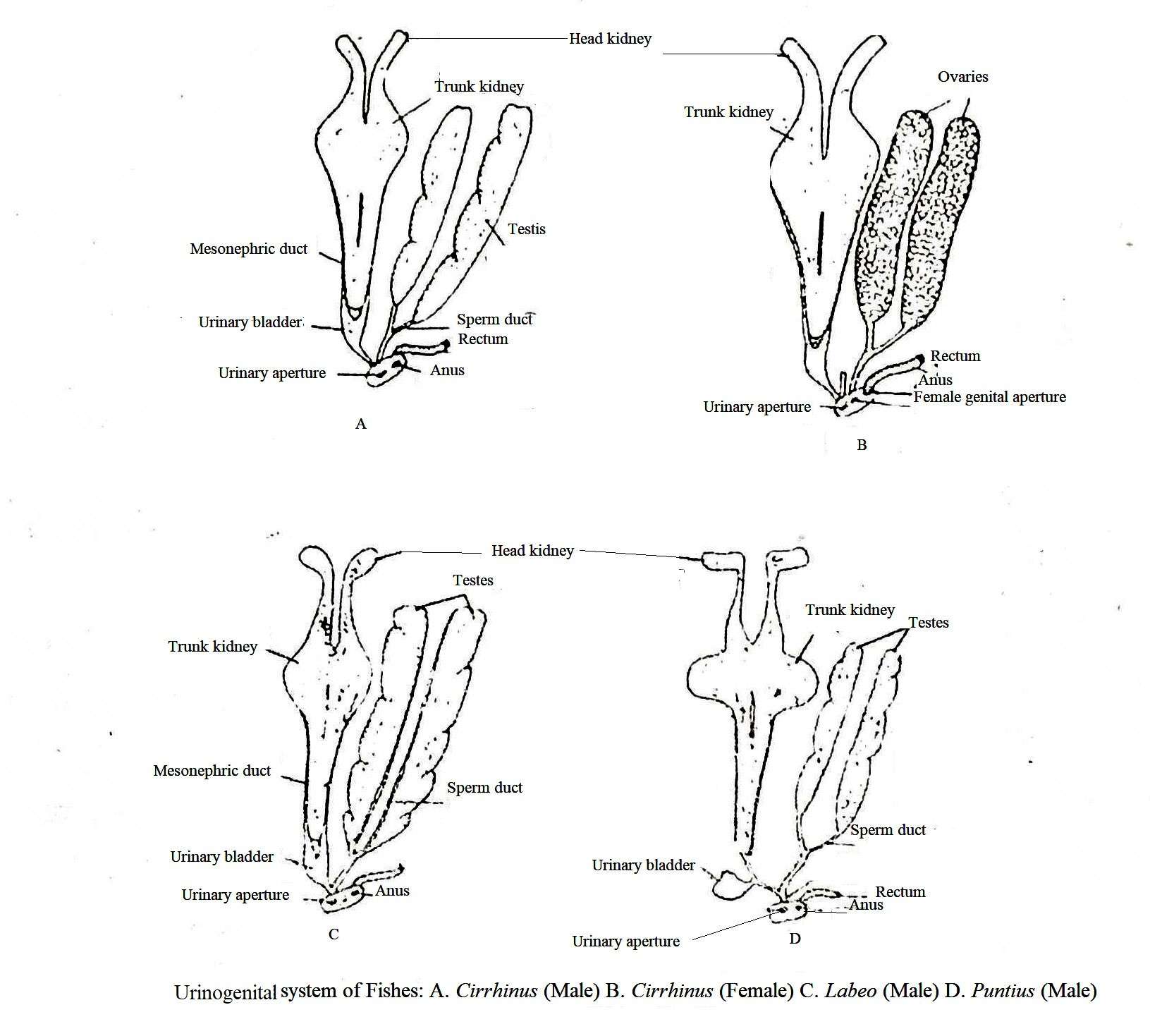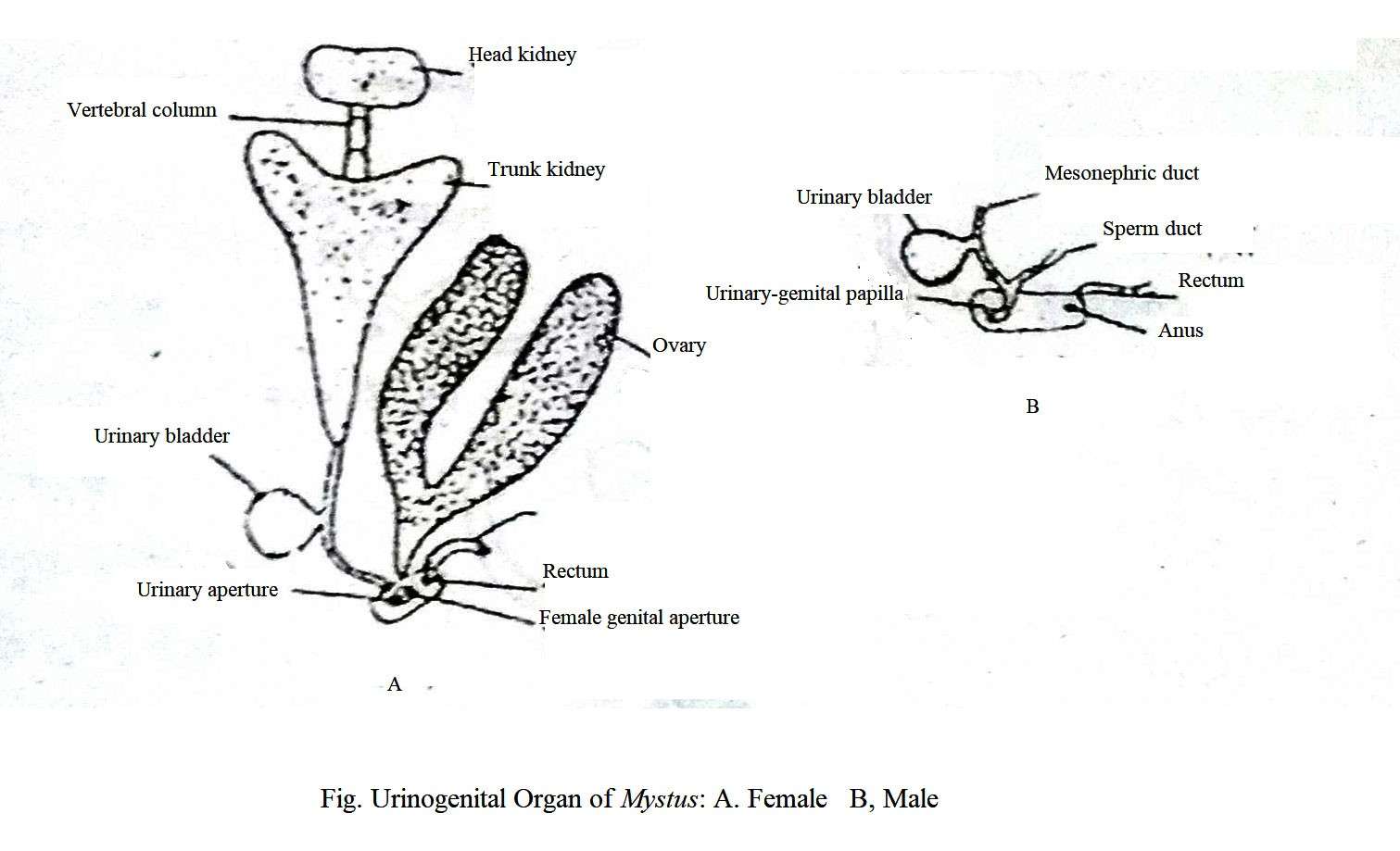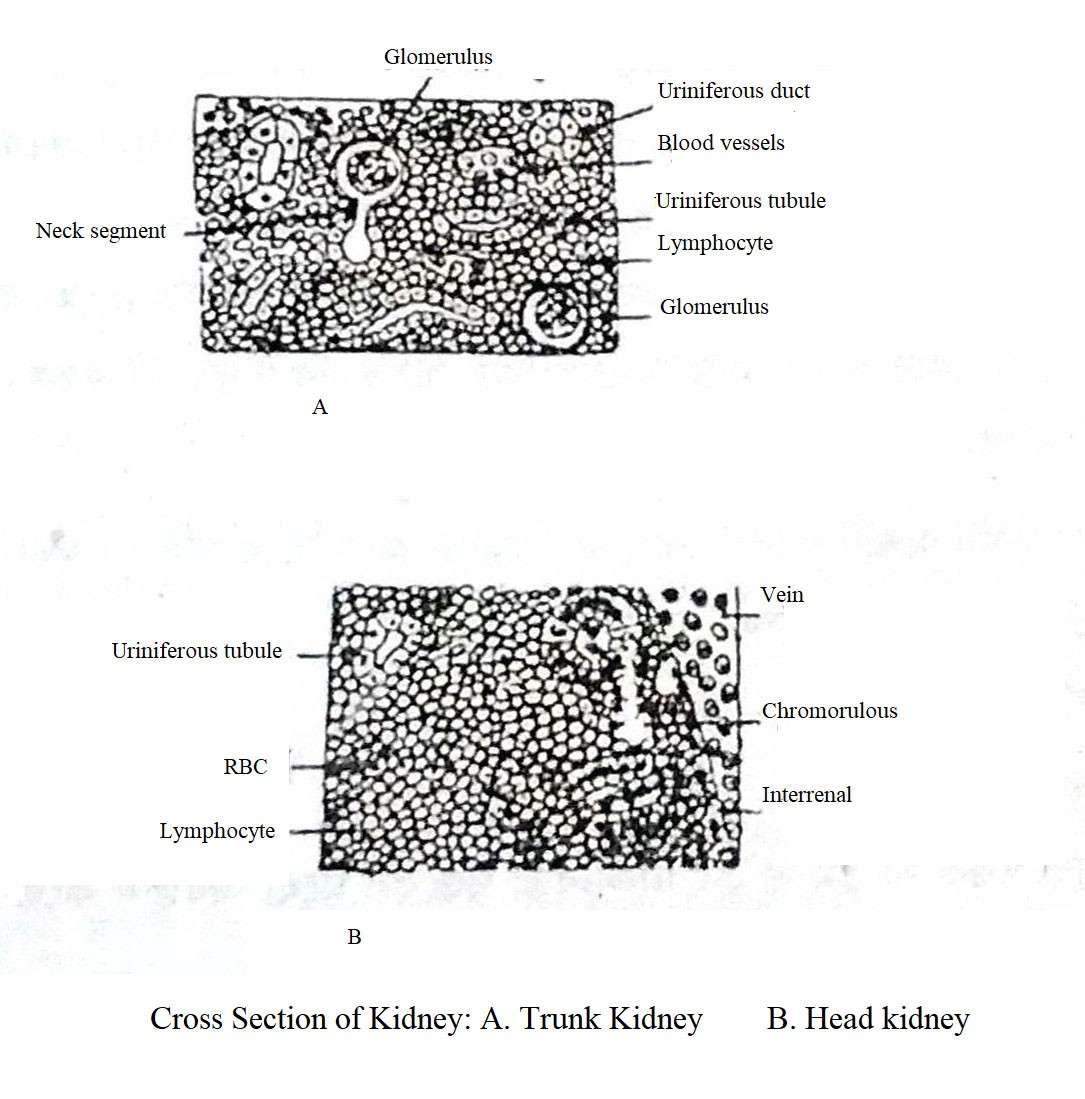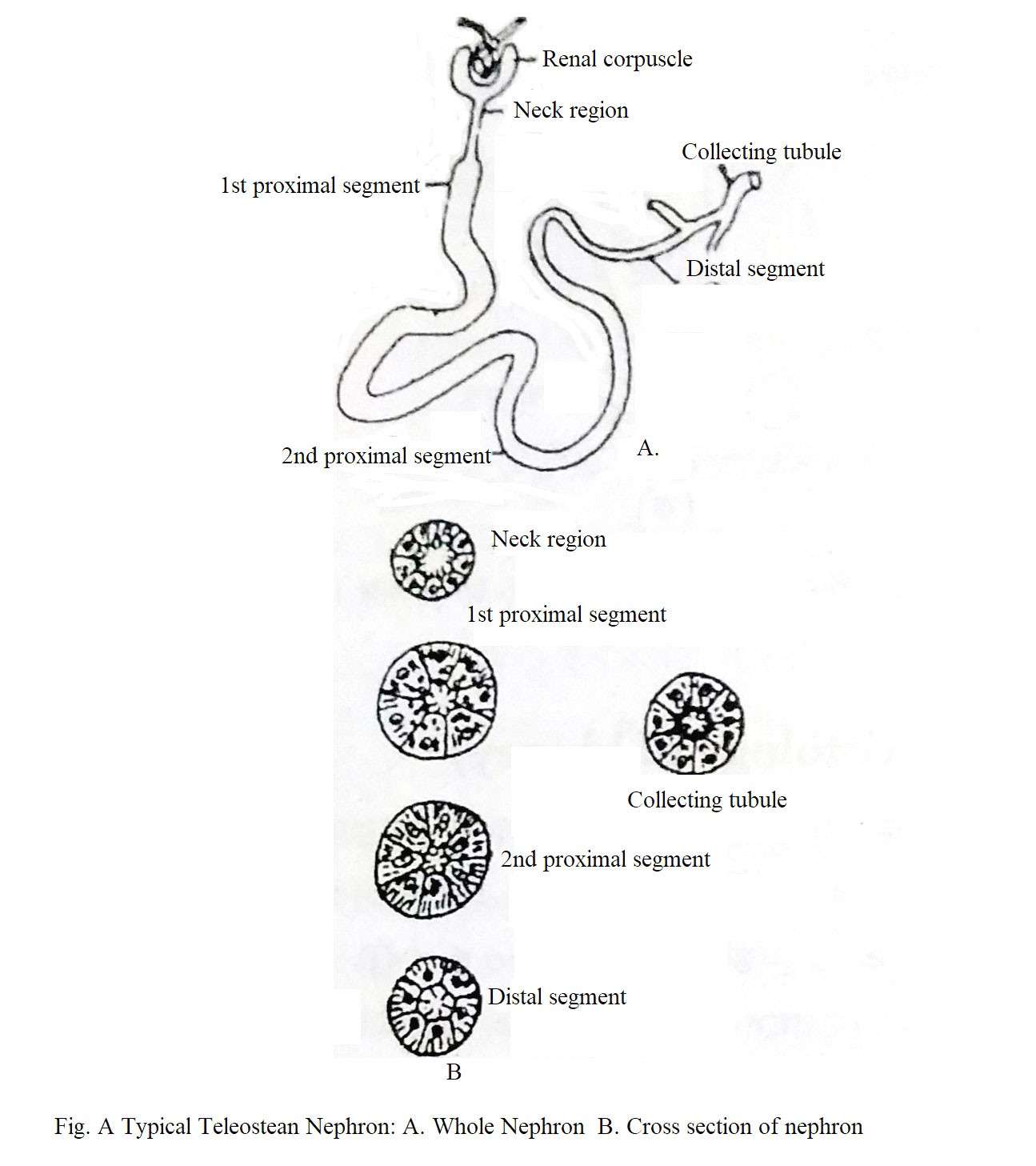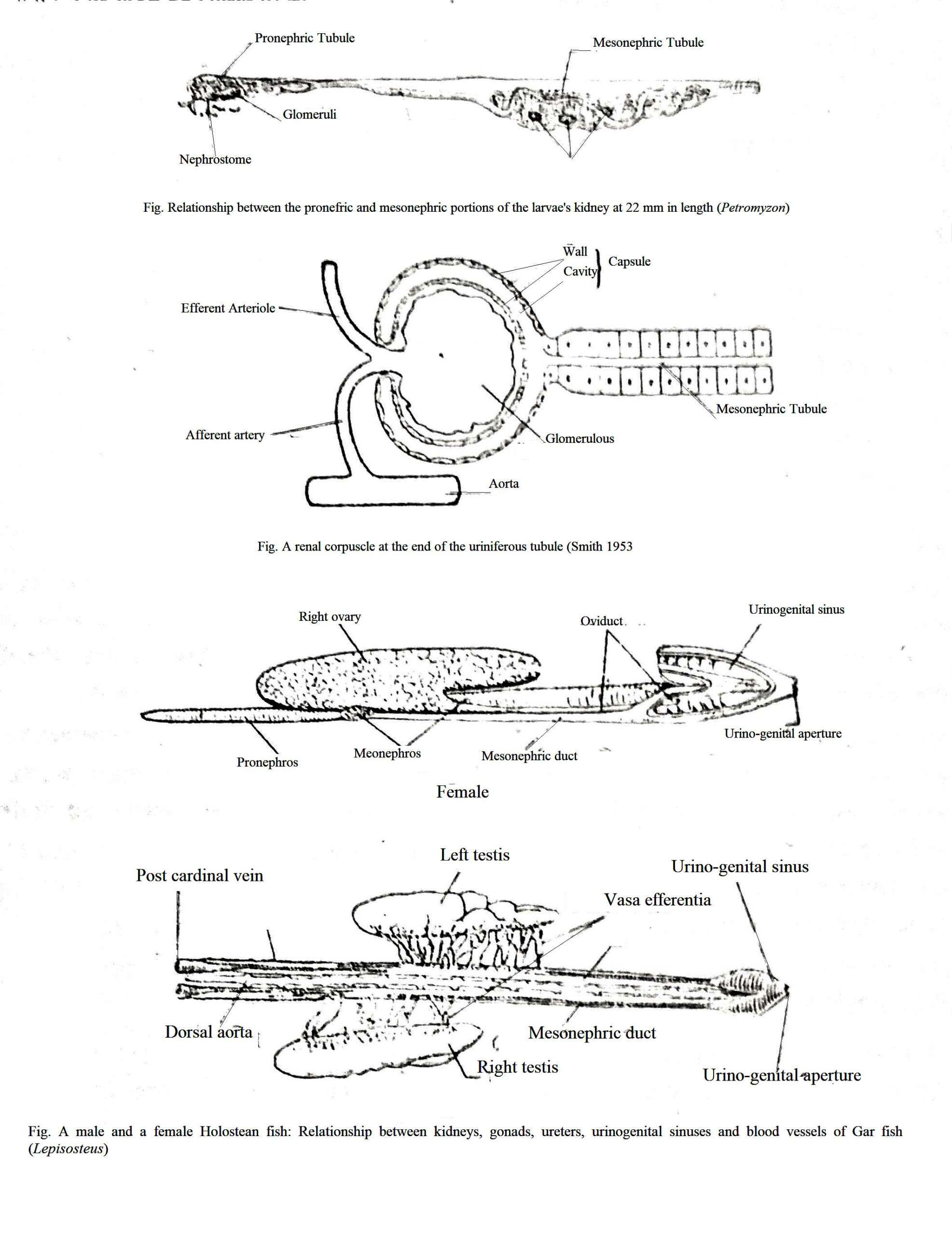Different parts of the body, especially the excretory system, are involved in the removal of waste products produced by metabolism. The process of removing nitrogenous wastes from the body is called excretion. The subsidiary system of excretory function is known as excretory system. These excretory substances are formed by the accrual reaction of amino acids. In the process of deamination, the amino (- NH2) group is separated from the amino acid. Some of these by-products are essential for the body, while others are unnecessary or harmful. Naturally unnecessary and harmful substances need to be removed from the body.
Carbon dioxide (CO2) and water (H2O) are produced in the animal body through the oxidation process and protein metabolism results in the formation of nitrogenous waste products such as ammonia, uric acid, purines, etc. Although carbon dioxide and water are required to control some physiological processes, these substances are considered waste products when accumulated in large quantities and need to be removed from the body from time to time.
In the case of vertebrates, the skin, lungs, liver, and digestive tract help in excretion, but the main organ for this function is the kidney. The excretory system of vertebrates is made up of a pair of kidneys and some adjacent organs. This system is almost the same in all vertebrates. Although the kidneys of all vertebrates are particularly accustomed to the removal of nitrogenous wastes, not all animals have the same organs.
The vertebrate kidney is divided into pronefros, mesonephros, and metanephros according to the condition of nephros in mature animals. Although pronefros is found in all vertebrates in the embryonic state, only in some animals such as Bellostoma, Myxine, etc., it is an effective kidney in adulthood. However, such kidneys are also found in the embryos of reptiles, birds and mammals. Fish have mesonephric type kidneys.
Aquatic animals have no problem removing ammonia. This is why they are called amnotetic animals. Amnotelic organisms include crustaceans, polychaets, teleosts, amphibian tadpole larvae, etc.
There are some animals that live in the water for some time and on land for some time. They convert toxic ammonia in the liver into less toxic ammonia and later it into urea. Urea stays in the body longer than ammonia. Animals whose main excretory substance is urea are called ureotelic animals. Animals such as elasmobranch, amphibians and mammals are ureotelic animals.
Terrestrial animals are not able to remove water from their bodies due to low water content. In this case, the nitrogenous waste material is converted to a less toxic substance called uric acid. It is removed from the body in the form of crystals. Animals whose main excretory substance is uric acid are called ureotelic animals. Insects, gastropods, lizards, snakes and birds are among the ureotelic animals. Because the excretory and reproductive organs of the fish are very close together, so these two systems are collectively called the urinogenital system. However, excretion and reproductive system work separately.
Excretory Products in Fishes
The excretory substances produced by fish are ammonia, urea, uric acid, creatine, creatinine, amino acids and trimethyl amine oxide (especially marine fish). The kidneys, liver, gills and other tissues play an important role in the production and removal of these excretory substances. Protein foods are the main source of nitrogen. Ammonia production from proteins is shown through the following reactions:
Freshwater and saltwater fish`s urine contains very little nitrogen. However, freshwater fish urine contains less nitrogen than salt water. Most of the nitrogen is removed as ammonia through the gills. Highly permeable elements such as urea, amine or amine oxide are removed by the gills, but less permeable nitrogenous elements such as creatine, creatinine and uric acid are mainly removed by the kidneys. The following is a detailed description of ammonia, urea and trimethyl amine oxide:
Ammonia
Ammonia is the main component produced from nitrogen metabolism. It is a toxic substance formed by the deamination reaction of amino acids. No energy is required to make ammonia from proteins. The process of deamination produces free energy from glutamate. The reaction of glutamic acid dehydrogenase(enzyme) with the transamination system plays an important role in ATP production. NAD + or NADP + is required for glutamic acid dehydrogenase. When the amount of NAD + or NADP + decreases, they enter the oxidative phosphorylation chain.
Because ammonia is soluble in fat, it can spread without losing water. Ammonium (NH4+) is instantly converted to ammonia (NH3). The exchange efficiency of NH4+ with sodium absorption through freshwater fish gills has been known. The exchange of NH4+ and Na + plays two roles, namely, the removal of nitrogenous wastes and the support of Na+ storage. Very small amounts of ammonia are removed through the kidneys.
Studies by Braunstein (1939), Braunstein and Byechkov (1939) have shown that the main process of making ammonia is the deamination of amino acids through the transaminase system. In carp and other freshwater teleosts, gills act as sources of ammonia (Zydowo 1960, Makarewicz and Zydowo 1962). High activity of adenosine monophosphate amino hydrolase can be observed in the tissues of gills. At first, it is partially involved in the aminatiion of inosine monophosphate in the process of producing aspartate salts from aspartic acid. At the next step deamination of adenosine monophosphate occurs through AMP deaminase as shown in the following flow diagram:
Urea
Urea is a nitrogenous compound that is less toxic. It is more soluble in water than ammonia. It is produced from ammonia and carbon dioxide through complex ornithine cycles. It has been found in the blood of marine coelocanth (Latimaria chalumnae) which is probably produced in the liver through the ornithine-urea cycle. However, in the case of teleost, there is disagreement as to whether urea is produced through the ornithine-citrulline-arginine cycle.
Brown and Cohen (1960) failed to detect two enzymes called carbamyl phosphate synthetase and ornithine transcarbamylase in the liver of teleost. These two enzymes are involved in the first two stages of the ornithine cycle. Therefore urea is not produced in the liver of teleost through the ornithine cycle.
Purine is thought to be one of the main sources of urea in fish. Several researchers (Przylecki 1925, Stansky 1933, Brunel 1937) have found evidence of the presence of urate oxidase, allantoinase, and allantoicase in the breakdown of uric acid in the liver of many teleosts. It is considered that urea is produced through a three-step process which is given below:
Trimethyleamine Oxide (TMAO)
It is a mild alkaline non-toxic component producing from nitrogen metabolism. It is found in the blood and body fluids of fish, especially marine fish. It has an osmotic regulating role with urea. Freshwater teleosts contain trimethyl amine oxide at a much lower concentration than marine teleosts. Decreases in the concentration of trimethyl amine oxide have been observed in euryhaline fish, especially in salmon fish (Salmo salar). The amount of trimethyl amine oxide is increased in the tissues of marine phase of euryhaline fish.
Excretion in Fishes
Excretion and secretion control are closely related and in fish it is done through the gills and kidneys. Although gills are the main respiratory organ, they also act as an important excretory and osmoregulatory organs. The kidneys play an important role in removing nitrogenous wastes and maintaining water-salt balance (homeostasis). A kidney has numerous large ducts or nephrons that develop from front to back.
The ducts of the anterior region develop and form pronephroses which are active in the early stages of life. Most of the ducts in the posterior region develop and form mesonephros which become functional in later life. The ancestor of the craniates probably had a set of segmental ducts in the trunk region that formed into the archionephros and opened into an archionepric duct. Archionephros later became distinct and produced Pro, Meso, and Metanephros.
In fish, a functional pronephros is seen which is subsequently replaced by a mesonephric duct. These are exposed to the pronephric duct and later turn into the mesonephric duct. Many ducts in the anterior region of the mesonephros become narrowed and even extinct to form a lymphoid organ. In fish and amphibians, most of the posterior ducts are located behind the pronephros, so their kidneys are called ophisthonephros.
Structure of Kidney of Fishes
Kidneys are two in number with elongated structure. They are located above the alimentary canal and adjacent to the vertebral column. The kidney of teleost is usually divided into two parts, namely the head kidney and the trunk kidney. However, in many species, these areas cannot be separated from the outside. There is no definite difference in the shape of the kidney based on sexes. The kidneys of marine teleost can be divided into following five parts:
Type-1: In this case, the two kidneys are completely integrated. There is no difference between head kidney and trunk kidney. It can be observed in fish of the order Clupeiformes.
Type-2: In this case, the middle and posterior part of the kidney is integrated. There is a clear difference between the head kidney and the trunk kidney. It is found in marine catfish (Plotosidae) and eel (Anguillidae).
Type-3: In this case, only the posterior part of the kidney is integrated. The apex has two narrow branches. The head and trunk kidneys can be clearly identified. It is found in most marine fish of the family Belonidae, Scopelidae, Mugilidae, Scombridae, Carangidae, Cottidae and Pleuronectidae.
Type-4: In this case, the posterior end of the kidney is united. The head and trunk kidneys cannot be separated. Such kidneys are found in sea horse and pipe fish of the family Syngnathidae.
Type-5: In this case, the two kidneys are completely separate. Such kidneys are found in fish of the family Lophiidae.
The first three types of kidneys exist in freshwater teleosts. The fully integrated 1st type of kidney is found in Salmon and Trout of the family Salmonidae. The second type of kidney is found in fish (carp) of the family Cyprinidae. In this case, the middle and posterior part of the kidney are integrated. The free segment of the apex forms the head kidney and the integral part forms the trunk kidney.
In many species, the middle part of the trunk kidney is broad and the posterior part is gradually narrower. Such kidneys are found in Cirrhinus, Labeo and Puntius. The third type of kidney is found in many species under the family Cyprinodontidae, Gasterostidae and Cottidae. In this case, only the back part is united. Some fish such as Mystus, Amiurus and Dactylopterus have such kidneys. In this case, the head kidney is completely separated from the rest of the kidney.
The kidney usually has two mesonephric ducts and each crosses along the outer border of the corresponding kidney and is most clearly seen in the middle and posterior region of the kidney. The two ducts always meet to form a common duct. Such connections occur at the posterior end of the kidney (Mystus) or at a few points between the kidney and the urinary papilla. Before entering the urinary bladder, the two ducts remain separate (Labeo, Cirhhinus).
The common mesonephric duct may enlarge to form the urinary bladder, or it may have a specific sac-like structure on one side of the common mesonefric duct (Puntius). In male fish, the urinary bladder is usually exposed through a normal urinogenital opening and in females it is exposed through a separate urethral opening. The urinogenital opening of the male fish is located at the tip of a papilla.
Urethral opening and genital pores usually exist on the outside but in some species, a small cutaneous cloaca is formed and it is exposed in the ducts. Some species have a pair of abdominal pores on either side of the genital pore. Abdominal pore is a special type of opening that is exposed outside the coelom and the significance of these openings is not known.
Histology of Kidney
Histologically, the trunk kidney consists of numerous nephrons. Each nephron consists of a renal corpuscle or malpighian body and ducts, and their interductal space is filled with unevenly expanded lymphoid tissue. The head kidney is composed of lymphoid, hematopoietic, intrarenal and chromafin tissues (suprarenal) and does not contain renal corpuscles and ducts.
In some species, the lymphoid tissue of the head kidney has a small number of nephrons and collecting ducts. However, glomeruli and renal corpuscles are not usually present. The head kidney has no excretory role. It originates from the pronephric hematopoietic tissue, but in some teleosts, the mesonephros form the frontal growth of the head kidney. Renal material is found in the head kidneys in some teleosts. These look like of masonephric type.
In a freshwater teleosts, a typical nephron consists of the following parts:
(A) A renal corpuscles exists with well-developed blood vessels-rich glomerulus.
(B) A ciliary region of varying lengths which connects the renal corpuscle to the duct.
(C) There is an initial proximal segment with advanced brushborders and numerous lysosomes.
(D) A second proximal segment with rich in numerous mitochondria, exists with a weakly developed brush border.
(E) A narrow ciliated secondary segment exists which is absent in some species.
(F) A distal segment exists consisting of relatively clear cells and long mitochondria.
(G) A collecting duct system exists.
A typical nephron of marine glomerular teleost consists of the following parts, viz
(A) Renal corpuscles with glomeruli
(B) A very short cervical segment
(C) 2-3 proximal segments
(D) A secondary segment which lies between the 1st and 2nd proximal segments.
(E) Collecting tubule (marine fish does not contain distal segment) and
(F)) Collecting duct system;
Marine pleuronectids contain euryaheline glomerular nephron which consists of the following components, viz.
(A) Tiny glomerulus with weak blood vessels
(B) Neck or cervical segment with cilia
(C) 1st proximal segment
(D) 2nd proximal segment
(E) A ciliary duct and
(F) A collecting duct system
Also in dipnoid (lung fish) nephrons consist of the following parts, viz
(A) A renal corpuscles consisting of a glomerular rich blood vessels.
(B) A ciliary neck or cervical region
(C) 1st segment of proximal duct that contains small particles like lysosomes
(D) 2nd segment of the proximal duct
(E) Ciliary secondary segment
(F) Distal segment and
(G) A collecting duct system
Modification of Kidneys in Fishes
In some teleosts, small glomeruli are seen in the kidneys. Myxocephalus has a low number of glomeruli wtith poorly developed blood vessels. Others, on the other hand, have a very small number of glomeruli (Lophius) and in the mature stage, the glomeruli become ineffective due to disconnection between the glomeruli and the renal tubules. After all, some marine fish (Toad fish-Opsanus), including the Antarctic bony fish, have no glomeruli.
Renal corpuscles are numerous in freshwater fish, usually round in shape, and each contains advanced blood vessels rich glomerulus. The number, size, and shape of the renal corpuscles vary widely in marine fish. Renal corpuscles rich in large and well-developed blood vessels are rarely seen. The kidneys of many marine fish usually have poorly developed glomeruli, which are rich in very few blood vessels and are probably ineffective (Therapon jarbua, Arius, Myxocephalus). These fish may have a small number of medium-sized glomerulus as well as smaller glomerulus.
In some species, there is a central ductless part(Chirocentrus, Tricanthus, Myxocephalus) surrounded by capillary loops. A significant number of marine fish (Porichthys notatuy, Hippocampus and Syngnathus) have completely absent glomerular kidneys.
Lamprey larvae (Petromizonidae) have functional pronephric kidney until they are 12-15 mm long. They have a funnel in the nephrostome that is exposed to the pericardial coelom. The ionic equilibrium control technique of the developing gills and the permeability of the body fluids are determined on the basis of the penetration of the body fluids. Coelomic fluid travels through the glomeruli to the nephrostome.
The glomus is the circulatory component of the pronephric duct that reabsorbs to preserve the blood component and the remaining purified fluid goes to the urino-genital sinuses. During larval development, the openings of the pronephric kidney become extinct in the coelom and mesonephric kidney develops there. Arterial blood filtrates through the glomeruli without any selective reabsorption. Later, salts and other elements are reabsorbed in the convoluted duct.
With some exceptions, such as boffin (Amia) and Gar (Lepisosteus), the nephrostomy opening goes to the anterior coelom. In the mature freshwater ray finned fish, coelom does not connect with the mesonephric kidney. Here excess water circulates from the blood through the glomerulus and salts and sugars are reabsorbed by the epithelium of the renal tubules and enter the bloodstream through the capillaries. A typical freshwater ray finned fish (Actinopterygian) has numerous glomeruli. These are larger than the glomeruli of standard marine ray finned fish and their blood supply is well-developed.
As the kidneys of freshwater fish are larger than the body weight of marine fish, more water flows through this organ. Some freshwater fish species have more than 10,000 glomeruli in a kidney. In contrast, true marine fish have far fewer glomeruli. The salinity of the environment is related to this feature, as marine fish have much lower glomeruli than freshwater salmon (Onchorhynchus) of the same age. Moreover, differences in the diameter of the glomerulius are also observed. Some freshwater fish have a diameter of glomeruus of 47-104 microns (average 71 microns). On the other hand, in some marine fish it is 26-94 microns (average 48 microns).
The fish’s kidneys receive dual blood supply through the renal arteries and portal veins. When the renal arteries send blood to the glomeruli, high blood pressure in the arteries helps to make glomerular filtrate. The renal portal vein connects to the capillary reticulum and surrounds the renal canal. Blood enters the glomeruli from the capillary blood vessels through the renal portal vein. All blood leaves the renal region through post-cardinal veins, but renal portal circulation is absent in lamprey and hagfish (Cyclostomata).
Excretory Process in Fishes
Vertebrates excrete nitrogenous wastes from the body through the intestines and skin. However, most metabolic wastes are excreted through specialized excretory organs. The glomerulus and bowman capsules act together as ultrafiltration and here the blood is filtered at high pressure. Under the influence of the overall filtration pressure, excretion of fluid flows through the renal ducts as a result of the movement of the long cilia of the neck segment and the cilia of other segment. Most of the sodium (Na +) and chloride (Cl–) ions are completely reabsorbed from over-filtration. Most of the glucose is removed by the same process.
In freshwater fish, the kidneys play an important excretory role in removing secondary nitrogenous compounds such as creatine and uric acid from the body, but the gills are the main organ through which major nitrogenous wastes such as ammonia (NH3) and urea are removed from the body. The magnesium (Mg ++) and sulfate (SO4—) that enter the intestines of marine fish from water are removed by the kidneys. Other ions such as sodium (Na+), chloride (Cl–), potassium (K+) and calcium (Ca ++) ions are also removed. Freshwater teleosts have more urine flow than marine fish. The process of filtration and reabsorption is regulated by different types of hormones.
Urine of freshwater fish have creatine, creatinine and unknown nitrogen compounds that contain some amino acids, a little urea and ammonia. The amount of nitrogen in the urine of freshwater fish is 2-25%. Fish gills emit large amounts of ammonia, and in the case of Cyprinus, it is 56%. The remaining nitrogenous substances are urea and other simple nitrogenous compounds are also excreted through the gills.
The amount of urine in fish depends entirely on the penetration of water into the body surface, gills and oral membranes. Not all fish have the same amount of impermeable mucus. Water circulates 20 times faster in the lamprey (Lampetra) than in the eel (Anguilla), and twice as fast in the body of goldfish (Carassius).
Freshwater fish produce large amounts of urine with a much lower concentration than body fluids. Lamprey produces 15-35% urine of her body weight every day. In freshwater bony fish (osteichthyes), on the other hand, it is account for 5-12%. In the case of freshwater fish, the freezing point of urine is approximately 0.0250C but higher levels are rare. However, in the African lung fish (Protopterus) its value has been recorded at 0.090 C.
The main function of kidneys of freshwater fish is to secrete water and some nitrogenous compounds. The kidneys also reabsorb sugar and other essential dissolved substances. The body of freshwater fish loses some of the salts that are hypertonic than the surrounding liquid, which is replenished through selective reabsorption through gills.
The multifaceted diffusion of matter from the body of the fish depends on the ratio of the surface of the body to the gills. Small fish with high metabolic demand have larger gill surface area than large fish. Differences in gill surface and body surface are also seen in fish of the same species. The size of the gill surface is very small than the body surface in the lamprey. The composition of urine indirectly depends on the temperature in addition to the amount of water taken through the gills and mouth.
Lamprey (Petromyzon) produces 60 ml of urine per kg body weight daily at a temperature of 20-30 ০C. On the other hand, at a temperature of 180 C, 500 ml / kg of urine is produced daily. This rate of urine production fluctuates between 8-50% of body weight. Freshwater bony fish rarely produce more than 20% of urine by body weight daily, and in terrestrial mammals this amount is 1-5%.
In some freshwater bony fish, invagination is sometimes formed behind the mesonephric duct to preserve urine, called the urinary bladder. Some salts in fish, especially chloride, are removed through urine and mucus. In addition, the gills and mouth lose about the same amount of chloride as other parts of the body. The rate of total chloride loss through urine also varies from fish to fish.
In Lamprey (Petromyzon) and some Salmoninae fish, this ratio is 1: 100, on the other hand, in Cyprinus, it is 1: 35. However, the chlorine filtered in carp is again reabsorbed in the renal ducts. The total amount of chloride lost varies at a significant rate, such as Lamprey (Petromyzon) loses 7 times more chloride than carp (Cyprinus sp).





